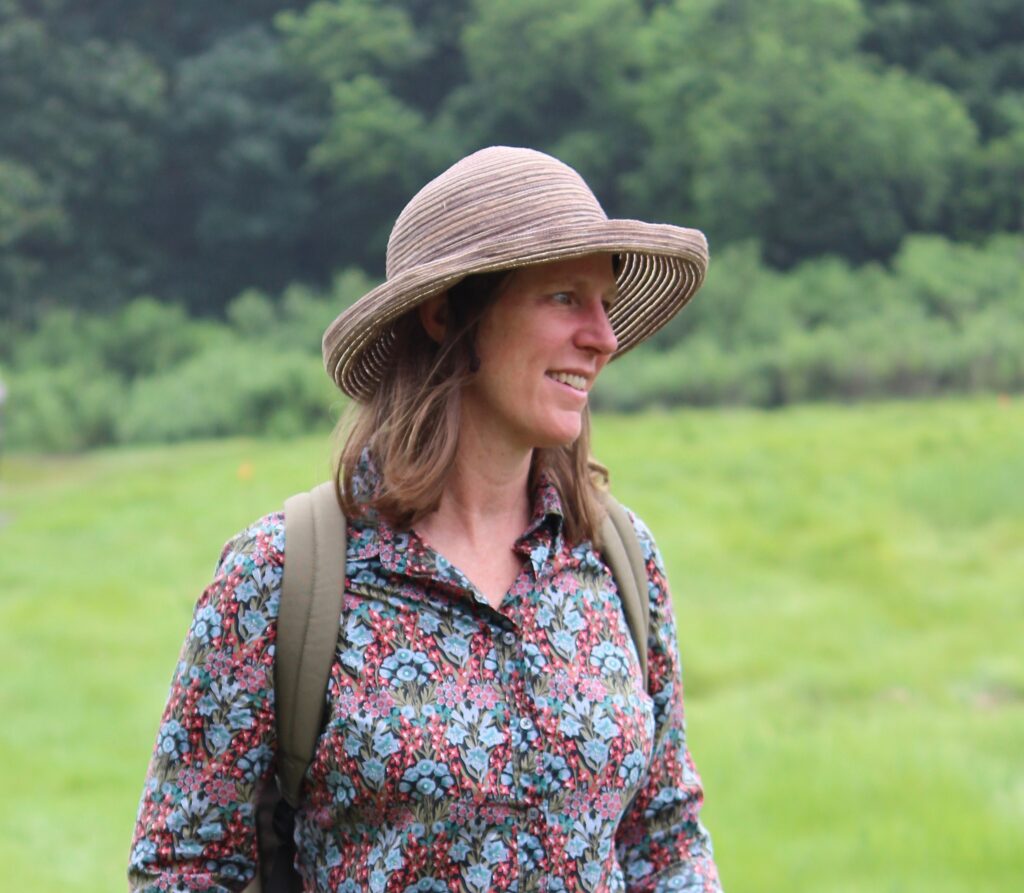Inspired by the Book is a series of interviews with Connecticut College folks about their literary lives. Inspiration comes from The New York Times Book Review series called By the Book.

Maggie Redfern is associate director of the Connecticut College Arboretum. She loves big old trees, growing trees from seed and leading walking tours focused on the importance of native trees. She hasn’t authored any books yet.
What books are on your night stand?
My “to read” list is a long one and people are always recommending more books! My current pile includes World of Wonders: In Praise of Fireflies, Whale Sharks, and Other Astonishments by Aimee Nezhukumatathil; Rachel Carson’s The Sea Trilogy which compiles three of her books on maritime ecology; Cal Flyn’s Islands of Abandonment: Nature Rebounding in the Post-Human Landscape; and Kim Robinson’s The Ministry for the Future. The current issue of The New Yorker is also there.
Describe your ideal reading experience (when, where, what, how).
Winter is a great time to read. The days are so short, there isn’t much in the garden that needs tending and the water is too cold to go swimming. I love to sit in front of the fire in a comfortable chair and dive in. The fire is conducive to letting my mind focus on the book.
Which genres do you especially enjoy reading?
Anything that expands my knowledge of trees and the environment. Although there are many non-fiction books about trees, those that I am most interested in are the ones that are so well researched and read almost like a novel or memoirs that weave in natural history. Robin Wall Kimmerer’s Braiding Sweetgrass, Andrea Wulf’s Brother Gardeners; Unbowed: A Memoir by Wangari Mathai, The Star Thrower by Loren Eisley, and most recently Tiya Miles’ All That She Carried: The Journey of Ashley’s Sack, a Black Family Keepsake – which I just happened to be reading when it was announced as a National Book Award Winner. Last winter I saw Tiya speak through a Zoom program on pecan trees presented by the Arnold Arboretum. And then just recently I noticed her book on the new books shelf in Shain Library. It is such a delight to read, so many interests combined from textiles and pecans to women’s history and the missing voices in our archives.
What’s the last great novel you read?
The Overstory by Richard Powers. Fiction set amongst the trees. Telling history over a long time, a tree’s time and connecting the human characters with the trees. Although fiction, it is based on several real life people and many species of real life trees.
Are there any classic novels that you only recently read for the first time?
I might be stretching the definition of classic but I finally read The Parable of the Sower by Octavia Butler. It came up during an early pandemic reading group focused on Michelle Neely’s Against Sustainability. Published in 1993, it takes the form of a diary written beginning in 2024. I don’t usually read much science fiction but post-apocalyptic novels that project a future based on human impacts to the environment draw me in. Plus it’s set in a California where no one drives on the freeway, instead they walk. Although they are fleeing their homes and have lost nearly everything. And our protagonist, Lauren, fled her home with a survival pack including seeds to plant in the future and a land ethic to fertilize the soul.
What’s the most interesting thing you learned from a book recently?
Canopy biologist Meg Lowman’s Arbornaut (like astronaut but in the trees not space) proclaims that half of land-based plants, insects and animals live in our treetops. Foresters used to only walk on the ground to study trees and they only knew what was on top when they cut the tree down so we never had thorough knowledge of the whole tree or what was living in it. Lowman developed techniques for getting to the tree tops to study life up there where there are still many more species to discover, most are microscopic but they all contribute to the web of life.
What’s your favorite book no one else has heard of?
Wild Gardener in the Wild Landscape of which very few print copies remain available. Fortunately the amazing reference staff at Shain Library helped me to digitize it and make it available on Internet Archive.
Which writers—novelists, playwrights, critics, journalists, poets—working today do you admire most?
Anyone who can change culture for the better. I’m thinking of Doug Tallamy and the few books he has written that have influenced a shift from planting exotic ornamental plants to growing native and restoring our landscape to be ecologically beneficial. He makes a compelling case for how an individual can make a difference. (Hint: everyone should plant an oak tree!)
You’re organizing a literary dinner party. Which three authors, dead or alive, do you invite?
Peter Del Tredici, botanist and author of Wild Urban Plants of the Northeast: A Field Guide; William A. Niering, ecologist who amongst other things spent his career at Connecticut College and created the Smaller American Lawns Today movement; and Rebecca Solnit, author, environmentalist, placemaker, and climate optimist.
May 3, 2022 at 1:36 pm
Have you read The Hidden Lives of Trees, by Peter Wohlleben? I love your reading selections and will have to add them to my list.
May 9, 2022 at 2:41 pm
Speaking for Maggie here, which is not fair but hopefully helpful, I can say that I’ve seen The Hidden Lives of Trees among Maggie’s books and she’s said a few things about it so I’m sure she’s read it. -Andrew
May 9, 2022 at 2:11 pm
Inspiring as always Maggie!!!